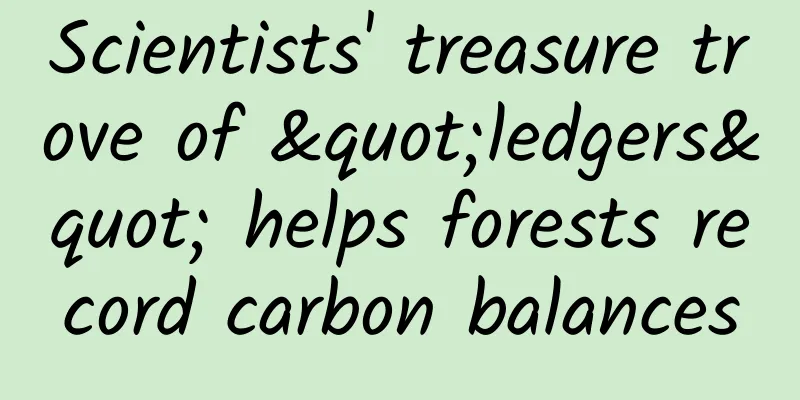Scientists' treasure trove of "ledgers" helps forests record carbon balances

|
As a carbon sequestering superman, the forest ecosystem is actually also emitting carbon When we talk about forests, the first thing that comes to mind is tall trees with luxuriant branches and leaves. As a large family of terrestrial plants, forests absorb carbon dioxide from the atmosphere and release oxygen through photosynthesis. They are the "carbon fixation superman" and natural oxygen bar in terrestrial ecosystems, and have made important contributions to alleviating climate warming caused by greenhouse gases such as carbon dioxide. This is also supported by evidence. According to a study conducted by the Chinese Academy of Sciences on the “Carbon Balance Certification and Related Issues in Addressing Climate Change” (hereinafter referred to as the “Carbon Project”), the “Ecosystem Carbon Sequestration” project shows that China’s forest ecosystem is the main carbon sequestration body, contributing about 80% of the carbon sequestration. Figure 1 Forest ecosystem (Photo source: veer photo gallery) However, we often overlook one issue: in addition to absorbing carbon dioxide through photosynthesis and thus fixing carbon, forest ecosystems are actually releasing carbon through respiration. The so-called "carbon balance" is obtained by subtracting carbon emissions from carbon absorption. When carbon absorption is greater than carbon emissions, it appears as a carbon sink , which is what we usually call forest carbon sink . If carbon emissions are greater than carbon absorption, it appears as a carbon source. Carbon sequestration is not that simple. Let’s calculate the “income and expenditure account” In order to obtain forest carbon sinks, carbon absorption must be greater than carbon emissions. Let’s now take a look at how to calculate this “income and expenditure account”. Forest carbon sinks are measured by the size of the components of the forest ecosystem carbon cycle. The amount of organic carbon fixed by plants absorbing carbon dioxide from the atmosphere through photosynthesis forms the gross primary productivity (GPP). To calculate the value of forest carbon sinks, the amount of carbon emissions must be subtracted. First, it is necessary to subtract the respiratory consumption of the aboveground parts and underground roots of the plant to convert it into net primary productivity (NPP). The net primary productivity is specifically manifested as the annual growth of the aboveground and underground biomass of the plant and the amount of litter (such as fallen leaves, branches, flowers, fruits, etc.), which can be directly measured. Secondly, plants grow on the soil, and as a complete ecosystem, the consumption of heterotrophic respiration of soil microorganisms should also be subtracted to finally obtain the net ecosystem productivity (NEP), that is, the forest carbon sink. Of course, considering a larger temporal and spatial scope, it is also necessary to subtract non-respiratory carbon release caused by various natural and human interferences (such as fire, pests and diseases, and logging). Figure 2 Schematic diagram of the carbon cycle in forest ecosystems (Image source: self-made by the author) In forest carbon emissions, the process by which soil produces and releases carbon dioxide into the atmosphere is often referred to as soil respiration (i.e. soil carbon emissions), which mainly includes heterotrophic respiration of microorganisms decomposing organic matter and autotrophic respiration of roots. The determination of soil carbon emission usually involves placing an air chamber over the surface for a certain period of time and calculating the soil carbon emission rate by measuring the change in carbon dioxide concentration over time. The determination of carbon dioxide concentration is currently often done by infrared gas analysis or gas chromatography. Soil respiration is an underground "black box" and there is still a lot of uncertainty. This account is very complicated, and if we want to figure it out clearly, we need the help of scientists. Figure 3 Soil respiration measurement chamber (Photo credit: Photo taken by the author) Forest ecosystem database: a treasure trove of carbon balances my country has carried out a lot of research work in the field of forest ecology. By systematically sorting out and summarizing the research results of predecessors, databases of various components of the carbon cycle of China's forest ecosystem have been constructed, such as the biomass database (Luo et al., 2014), the litter database (Jia et al., 2016), and the soil carbon emission database (Sun et al., 2022), as well as forest resource inventory data and carbon special survey data. A large amount of precious data has been accumulated on a national scale from carbon absorption to carbon emissions, which is the result of the unremitting efforts of several generations of scientific workers to conduct field surveys and measurements on sample plots. These data can effectively serve my country's strategic goals of carbon peak and carbon neutrality. For example, the carbon absorption, emissions and carbon sink size of my country's forest ecosystems can be calculated in combination with forest distribution area; dominant climate factors (such as temperature, precipitation, etc.) can be used to establish a model to predict the changing trend of my country's forest carbon balance under future climate change scenarios; from the perspective of reducing emissions and increasing carbon sinks, we can explore management measures to promote forest carbon fixation in different regions (such as the selection of afforestation tree species, the determination of the maximum growth stage of carbon fixation, and the appropriate density, etc.) according to local conditions, and ultimately provide basic data and scientific support for the accurate assessment and prediction of forest carbon sinks and the formulation of appropriate forest management measures. Recently, the Institute of Botany, Chinese Academy of Sciences, has constructed a database of forest soil carbon emissions at different time scales , including detailed information such as soil carbon emission rates and observation methods, geographical locations, forest stand characteristics and climate factors from hourly, monthly to annual scales, with a total sample size of 11,297 entries. Research shows that the annual carbon emissions from my country's forest soils vary between 260–2058 g C m^(-2) yr^(-1), with an average of 852 g C m^(-2) yr^(-1). Generally, within the same climate zone, evergreen forests emit more carbon than deciduous forests, and broad-leaved forests emit more carbon than coniferous forests. It is worth noting that bamboo forests, which have often been neglected in previous large-scale forest carbon emission studies, show the highest carbon emission rate, with an average of 1134 g C m^(-2) yr^(-1). The establishment of this database has important theoretical and practical significance for studying the forest carbon cycle in my country and even the world and reducing the uncertainty of large-scale carbon balance assessment, and serves the realization of my country's "dual carbon goals". Figure 4 Comparison of soil carbon emissions in China's forest ecosystems in different climate zones EBF: evergreen broad-leaved forest, DBF: deciduous broad-leaved forest, ENF: evergreen coniferous forest, DNF: deciduous coniferous forest, MF: mixed coniferous and broad-leaved forest, BB: bamboo forest. (a) cold temperate zone, (b) temperate zone, (c) subtropical zone, (d) tropical zone. (Image source: self-made by the author) Towards the goal of dual carbon, scientific research is on the way "Carbon peak and carbon neutrality" need the support of science and technology. The dual carbon goals we put forward are by no means intended to reduce everyone's quality of life, but to contribute to protecting our common home and achieving sustainable development of mankind. Among them, scientific and technological innovation is the key to achieving economic and social development and carbon peak and carbon neutrality at the same time. In March 2022, the Chinese Academy of Sciences also officially announced the "Strategic Action Plan of the Chinese Academy of Sciences for Science and Technology Support for Carbon Peaking and Carbon Neutrality". Now, not only scientists in the field of carbon sequestration, but also power generation and energy consumption are making efforts. There are also a series of basic scientific issues that need to be studied in depth. Science and technology support for dual carbon is a long and arduous task, and we need to work harder! References: [1]Fang JY, Yu GR, Liu LL, Hu SJ, Chapin FS. 2018. Climate change, human impacts, and carbon sequestration in China. PNAS, 115, 4015-4020. [2]Jia BR, Zhou GS, Xu ZZ 2016. Forest litterfall and its composition: a new data set of observational data from China. Ecology, 97(5): 1365. [3]Luo Y, Zhang X, Wang X, Lu F. 2014. Biomass and its allocation of Chinese forest ecosystems. Ecology, 95(7): 2026. [4]Sun HR, Xu ZZ, Jia BR. 2022. A compiled soil respiration dataset at different time scales for forest ecosystems across China from 2000 to 2018. Earth System Science Data, 14(7): 2951–2961. Produced by: Science Popularization China Author: Jia Bingrui (Institute of Botany, Chinese Academy of Sciences) Producer: China Science Expo |
<<: Why was the “Internet celebrity” Mars regarded as a disaster star by the ancients?
Recommend
A complete analysis of social media methods for App operation and promotion!
In the era of mobile Internet, traffic is king. I...
Beware! This animal appears frequently after the rain, and many people have encountered it! Don’t touch it...
recent Heavy rain in Shenzhen One after another A...
These 7 habits you thought were "healthy" might be wrong!
my country's population has gradually shown a...
Rethinking wearables: The story behind Microsoft's smart wristband out of stock
When the wearable device market represented by sm...
Why is Seahorse Dad called "the best husband in the animal world"?
Every spring, many animals start preparing for re...
Listen to the advice! Don’t use the quick wash mode of your washing machine indiscriminately!
Planning and production Source: Dr. Curious Edito...
iQIYI Verb Wireless Earphones: 25 days of ultra-long standby, lightweight and luxurious wireless sound experience
What is the most important thing for young people...
The “strategic rifle” has not yet been officially put into service. What is the reason behind this?
...
With just 15 seconds of audio, AI can help aphasics “regain their voice”?
OpenAI shared some of their progress in AI speech...
Still giving birth at 74! You definitely don’t know the secrets of these birds
At the end of 2024, a black-backed albatross name...
Online marketing activity planning
The APP online promotion activity planning progra...
Original knowledge comedy "Zhu Bajie Learns to Express" Baidu Cloud Download
Among the four disciples of Tang Monk, Zhu Bajie ...
Why the stock price plummeted: Lenovo has fallen into the pain period of profit transformation
Recently, Lenovo released its interim financial r...
The 5th Global Mobile Game Conference IP Matchmaking Conference King IP gives new vitality to the game
In the China (Chengdu) Digital Entertainment Festi...
In-depth interpretation of "TikTok Enterprise Blue V White Paper": What should TikTok Blue V do?
At the end of June, Douyin released the "Dou...









